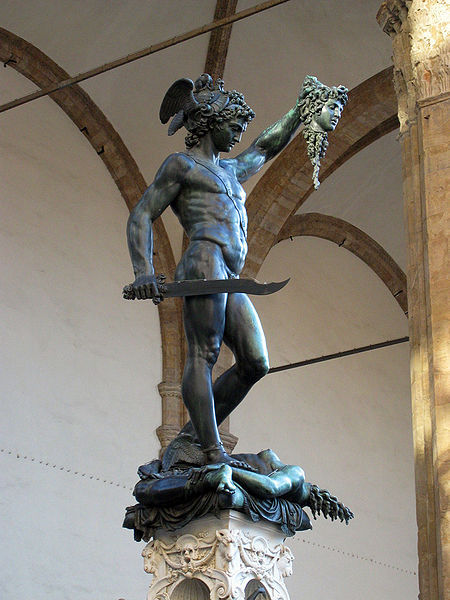Piazza della Signoria– The Piazza della Signoria is a an “L-shaped square” in front of the Palazzo Vecchio in Florence, Italy. It was created in the 13th century and has become an incredibly
 lively area due to its close proximity to the Palazzo Vecchio and the Uffizi Palace. The Piazza della Signoria is considered an “open air statue museum” because of the famous statues that it contains, including Michelangelo’s David, Herculus and Cacus, the Rape of the Sabines, the Rape of Polyxena, Perseus with the head of Medusa, and many more.
lively area due to its close proximity to the Palazzo Vecchio and the Uffizi Palace. The Piazza della Signoria is considered an “open air statue museum” because of the famous statues that it contains, including Michelangelo’s David, Herculus and Cacus, the Rape of the Sabines, the Rape of Polyxena, Perseus with the head of Medusa, and many more.

Loggia dei Lanzi– Loggia dei Lanzi is a building on the corner of the Piazza della Signoria in Florence, Italy. It was originally built between 1376 and 1382 by Benci di Cione and Simone di Francisco Talenti to house people and to hold public ceremonies. The Loggia dei Lanzi contains wide arches that open up to the street and its “severe architecture” is said to contrast that of the Palazzo Vecchio.
The Rape of the Sabines– The sculpture entitled “The Rape of the Sabines” was created by
 Giambologna and was made from an “imperfect block of white marble”. It is currently on public display at the Loggia dei Lanzi in Florence, Italy. The sculpture depicts three figures, a man lifting a woman in the air, while a second man crouches. This sculpture is based on an early Roman story in which the Sabines refused to allow their women to marry the Romans. The Romans are said to have grabbed the Sabine women and fought the Sabine men at a festival of Neptune Equester.
Giambologna and was made from an “imperfect block of white marble”. It is currently on public display at the Loggia dei Lanzi in Florence, Italy. The sculpture depicts three figures, a man lifting a woman in the air, while a second man crouches. This sculpture is based on an early Roman story in which the Sabines refused to allow their women to marry the Romans. The Romans are said to have grabbed the Sabine women and fought the Sabine men at a festival of Neptune Equester.
The Rape of Polyxena– The Rape of Polyxena is a “diagonal” statue located in the Loggia dei Lanzi in Florence, Italy. It was created by Pio Fedi in 1865. The statue depicts Achilles with Polyxena (the daughter of the king of Troy) in arm, stepping over her brother’s body.
Perseus Holding the Severed Head of Medusa– Perseus Holding the

Severed Head of Medusa is a bronze statue by Benvenuto Cellini located in the Loggia dei Lanzi in Florence, Italy. This statue was commissioned by Cosimo I de Medici and was revealed in 1554. The statue depicts Perseus, the Greek demi-god and hero, holding a sword, as well as the severed head of Medusa, a monster of ancient Greek mythology. In the statue, Perseus is naked and Medusa’s neck is covered in blood.
Atrium– In architecture, an atrium is “a large open space located within a building”. The Ancient Roman dwellings contained many atria, which would provide light and ventilation to an area. In the novel Inferno, Vayentha “passed through two ornate atriums” on her way to Il Museo di Palazzo (Brown 181).
Hercules– The Roman name for the Greek divine hero Heracles, the son of Zeus and the mortal Alcmene. Hercules is known for his strength and adventures. Vayentha saw a statue of Hercules and Diomedes in the Hall of the Five Hundred in which both statues were “stark naked- locked in a wrestling match” (Brown 182). This statue was commissioned by Cosimo I de Medici in 1560.
Diomedes– Diomedes is a hero of Greek mythology and is known for his participation in the Trojan War. He is featured in Virgil’s Aeneid and is one of the warriors who entered the Trojan Horse shortly before the sack of Troy. Vayentha saw a statue of Hercules and Diomedes in the Hall of the Five Hundred in which both statues were “stark naked- locked in a wrestling match” (Brown 182). This statue was commissioned by Cosimo I de Medici in 1560.
The video will go viral within minutes of its release: Dan Brown uses a pun in this phrase by saying that the video, about a virus that will spread the plague, will “go viral” (Brown 183).
Alexandra Fields
afields@middlebury.edu